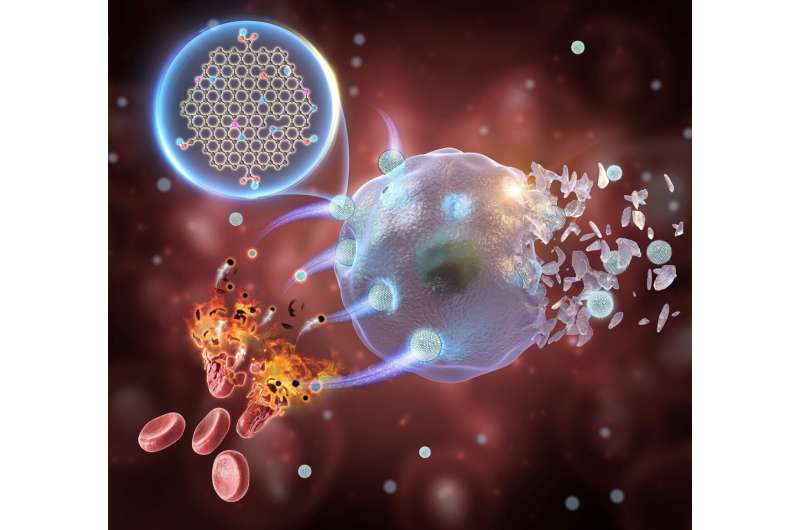
A research group led by Prof. Wang Hui from the Hefei Institutes of Physical Science (HFIPS) of the Chinese Academy of Sciences has introduced a metal-free nanozyme based on graphene quantum dots (GQDs) for highly efficient tumor chemodynamic therapy (CDT). The study is published in Matter.
GQDs represent a promising and cost-effective means of addressing the toxicity concerns associated with metal-based nanozymes in tumor CDT. However, the limited catalytic activity of GQDs has posed significant challenges for their clinical application, particularly under challenging catalytic conditions.
“The obtained GQDs, which are made from red blood cell membranes, are highly effective in treating tumors with few side effects,” said Liu Hongji, a member of the research team. “One of the advantages is that they are metal-free. In addition, they function as excellent peroxidase-like biocatalysts.”
To enhance the catalytic performance of the GQD-based nanocatalytic adjuvant, the researchers rationally designed GQDs using a diatomic doping strategy. The synergistic electron effect of introducing nitrogen and phosphorus into GQDs can generate highly localized states near the Fermi level, thus enabling efficient enzymatic activity compared to single heteroatom doping.
The obtained GQDs, derived from erythrocyte membranes, have been shown to possess impressive peroxidase-mimicking activity. As a result, the GQDs are highly effective at inducing apoptosis and ferroptosis of cancer cells in vitro. They also selectively target tumors, with a tumor inhibition rate as high as 77.71% for intravenous injection and 93.22% for intratumoral injection, with no off-target side effects.
This drug-free, target-specific, and biologically benign nanozyme has great potential as a potent biocatalyst for use in safe cancer treatment.
More information:
Graphene quantum dots as metal-free nanozymes for chemodynamic therapy of cancer, Matter (2024). DOI: 10.1016/j.matt.2023.12.005. www.cell.com/matter/fulltext/S2590-2385(23)00619-7
Journal information:Matter
Provided by
Chinese Academy of Sciences

READ MORE
Is there a difference between inline and V engine configurations?
There are actually three different engine configurations commonly used in automobiles: Inline — the cylinders [...]
Is there such a thing as negative-calorie food?
Is there such thing as a negative calorie food? Not quite. UpperCut Images/Getty Images Celery [...]
Why did Europe’s hunter-gatherers disappear?
There are many mysteries surrounding Europe’s hunter-gatherers, but farming played a role in their demise. [...]
Biologists Are Biased Toward Penises
An overly alluring research subject. Photo: Chris Hellier/ /age fotostock Spain S.L./Corbis Penises are amazingly [...]
What You Need to Know About Caulking and Health
Stockbyte/Getty DCL Air leaks can really sip the heat right out of a house. Our [...]
Scientists develop new device to detect brain tumors using urine
Microscopic image of nanowires. Credit: Dr Takao Yasui Researchers at Nagoya University in Japan have [...]
Is there a light 10 billion times brighter than the sun?
The Diamond synchrotron’s powerful light source could be used on a variety of scientific projects, [...]
Winemakers Are Building Houses for Bats to Make Vineyards Greener
A bat box stands over the Herdade do Esporão vineyard in Portugal. Courtesy of Esporão/Francisco [...]